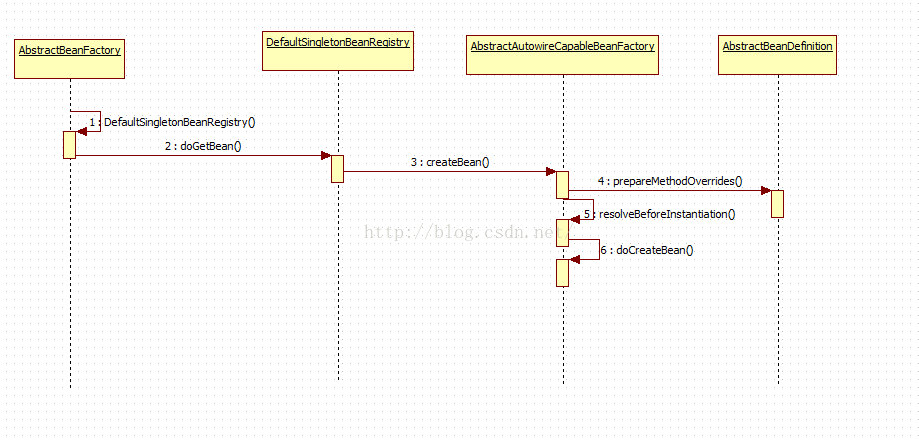Spring源码之bean的加载(五)准备创建bean
我们继续跟踪代码到createBean,也就是创建创建bean,一同来看一下createBean函数中做了哪些准备工作。首先,我们先来看一张时序图。(相关资源可到这里下载:http://pan.baidu.com/s/1sjSo9a9)
protected Object createBean(String beanName, RootBeanDefinition mbd, Object[] args) throws BeanCreationException {
if (logger.isDebugEnabled()) {
logger.debug("Creating instance of bean '" + beanName + "'");
}
RootBeanDefinition mbdToUse = mbd;
// Make sure bean class is actually resolved at this point, and
// clone the bean definition in case of a dynamically resolved Class
// which cannot be stored in the shared merged bean definition.
Class resolvedClass = resolveBeanClass(mbd, beanName);
if (resolvedClass != null && !mbd.hasBeanClass() && mbd.getBeanClassName() != null) {
mbdToUse = new RootBeanDefinition(mbd);
mbdToUse.setBeanClass(resolvedClass);
}
// Prepare method overrides.
try {
mbdToUse.prepareMethodOverrides();
}
catch (BeanDefinitionValidationException ex) {
throw new BeanDefinitionStoreException(mbdToUse.getResourceDescription(),
beanName, "Validation of method overrides failed", ex);
}
try {
// Give BeanPostProcessors a chance to return a proxy instead of the target bean instance.
Object bean = resolveBeforeInstantiation(beanName, mbdToUse);
if (bean != null) {
return bean;
}
}
catch (Throwable ex) {
throw new BeanCreationException(mbdToUse.getResourceDescription(), beanName,
"BeanPostProcessor before instantiation of bean failed", ex);
}
Object beanInstance = doCreateBean(beanName, mbdToUse, args);
if (logger.isDebugEnabled()) {
logger.debug("Finished creating instance of bean '" + beanName + "'");
}
return beanInstance;
}
从代码中,我们可以做以下的总结:
1) 根据设置的class属性或者根据className来解析Class。
2) 对override属性进行标记及验证
public void prepareMethodOverrides() throws BeanDefinitionValidationException {
// Check that lookup methods exists.
MethodOverrides methodOverrides = getMethodOverrides();
if (!methodOverrides.isEmpty()) {
for (MethodOverride mo : methodOverrides.getOverrides()) {
prepareMethodOverride(mo);
}
}
}
上面的方法中,我们要留意的是prepareMethodOverride函数,所以下面是这个函数的实现。
protected void prepareMethodOverride(MethodOverride mo) throws BeanDefinitionValidationException {
//获取对应类中对应方法的个数
int count = ClassUtils.getMethodCountForName(getBeanClass(), mo.getMethodName());
if (count == 0) {
throw new BeanDefinitionValidationException(
"Invalid method override: no method with name '" + mo.getMethodName() +
"' on class [" + getBeanClassName() + "]");
}
else if (count == 1) {
// Mark override as not overloaded, to avoid the overhead of arg type checking.
mo.setOverloaded(false);
}
}
3) 应用初始化前的后处理器,解析指定bean是否存在初始化前的短路操作
protected Object resolveBeforeInstantiation(String beanName, RootBeanDefinition mbd) {
Object bean = null;
if (!Boolean.FALSE.equals(mbd.beforeInstantiationResolved)) {
// Make sure bean class is actually resolved at this point.
if (!mbd.isSynthetic() && hasInstantiationAwareBeanPostProcessors()) {
Class targetType = determineTargetType(beanName, mbd);
if (targetType != null) {
bean = applyBeanPostProcessorsBeforeInstantiation(targetType, beanName);
if (bean != null) {
bean = applyBeanPostProcessorsAfterInitialization(bean, beanName);
}
}
}
mbd.beforeInstantiationResolved = (bean != null);
}
return bean;
}
上述方法,我们关心的是applyBeanPostProcessorsAfterInitialization的方法,下面给出其代码。
public Object applyBeanPostProcessorsAfterInitialization(Object existingBean, String beanName)
throws BeansException {
Object result = existingBean;
for (BeanPostProcessor beanProcessor : getBeanPostProcessors()) {
result = beanProcessor.postProcessAfterInitialization(result, beanName);
if (result == null) {
return result;
}
}
return result;
}
4) 创建bean
